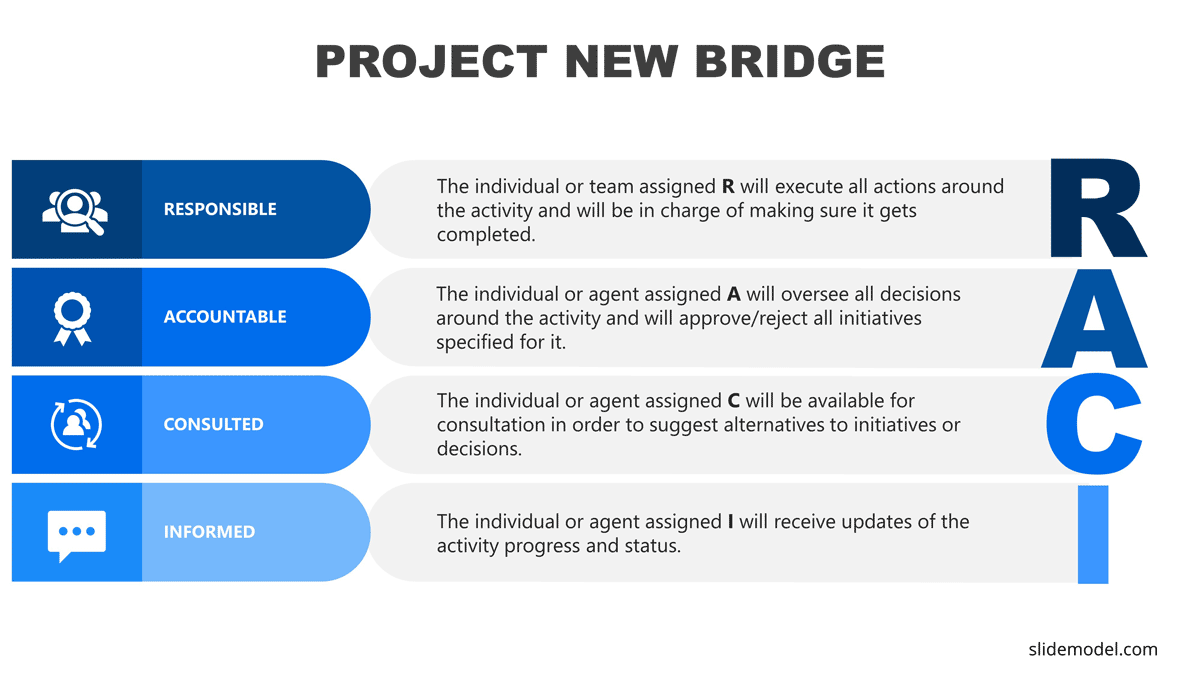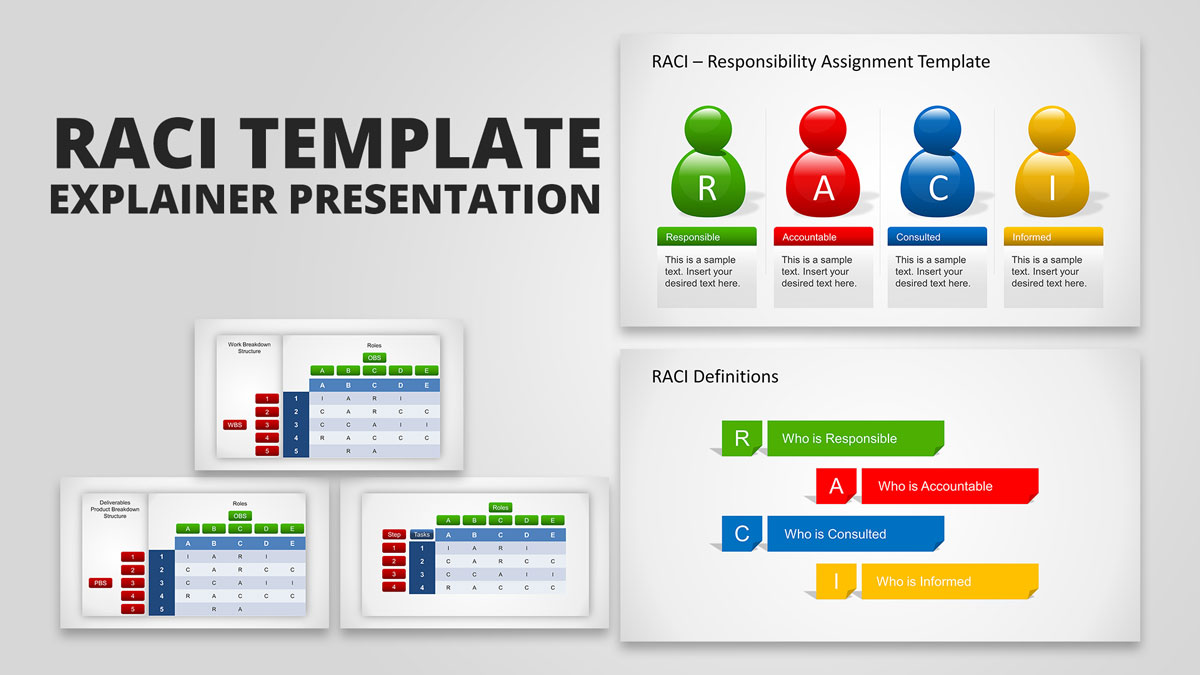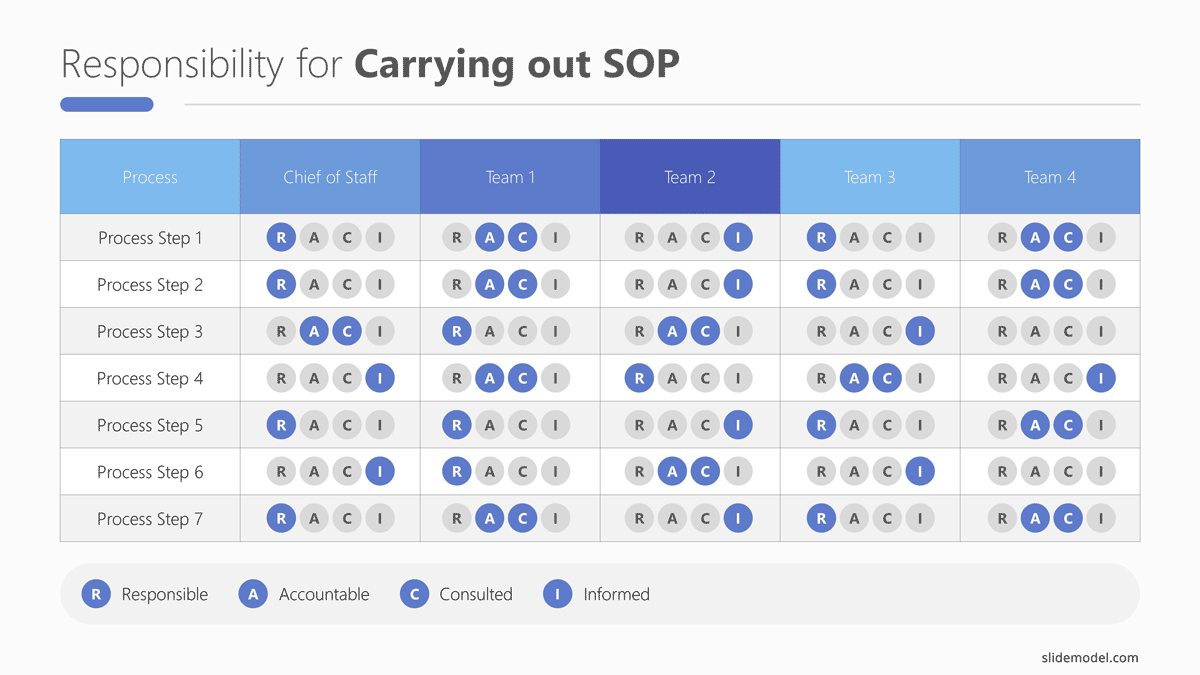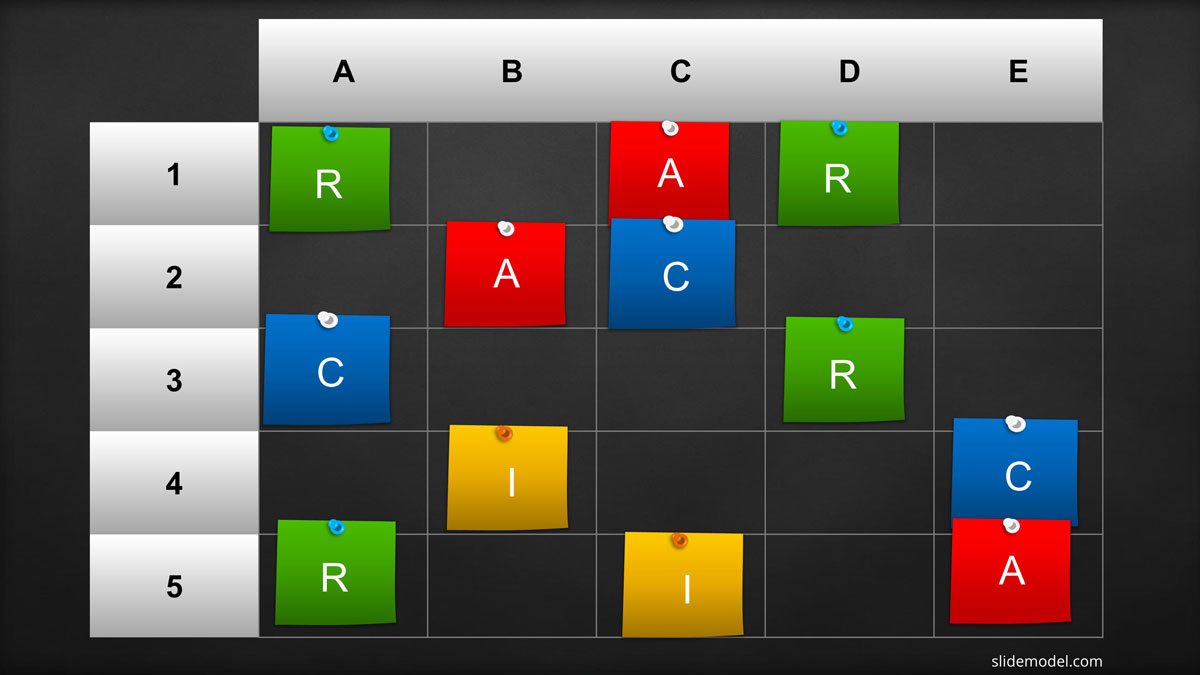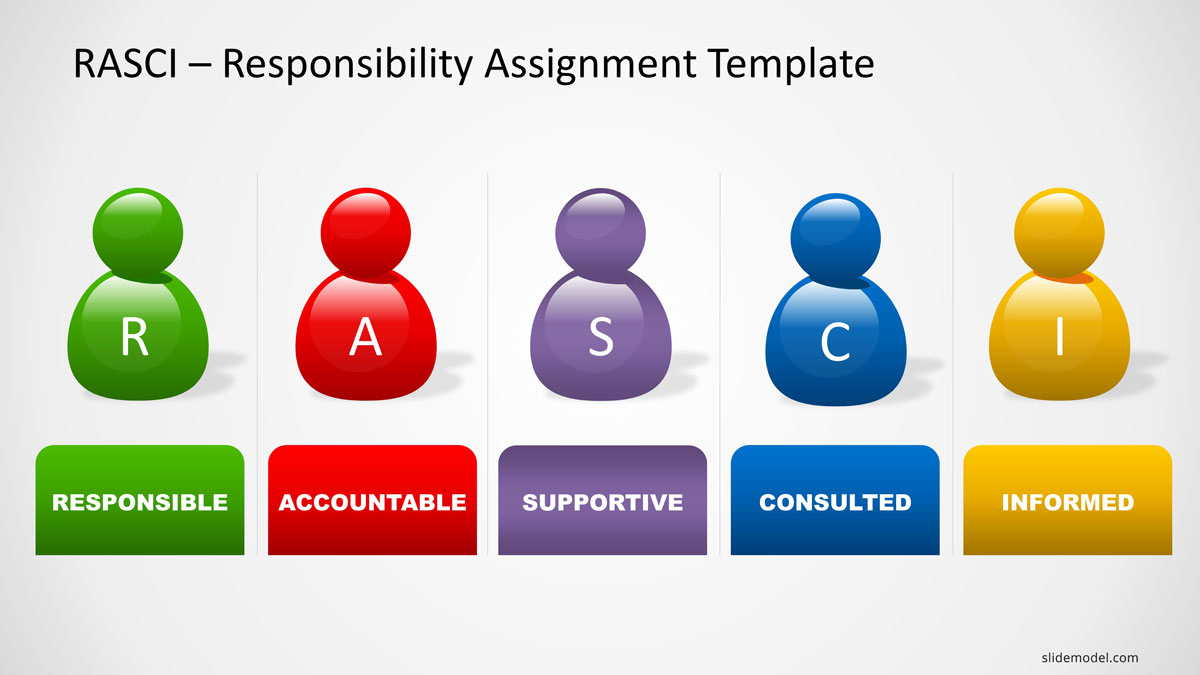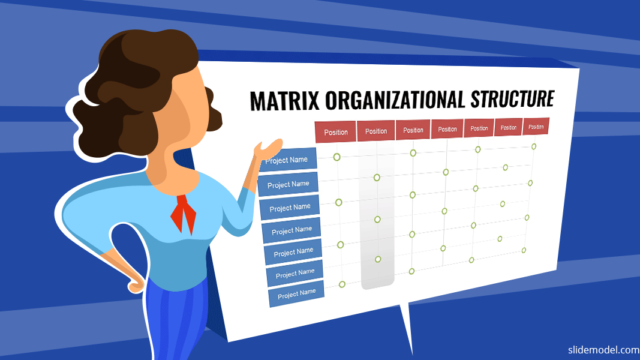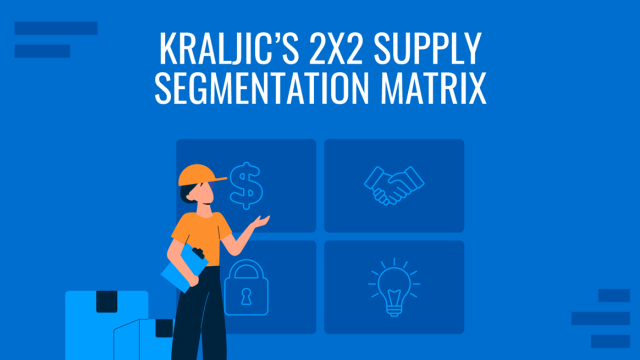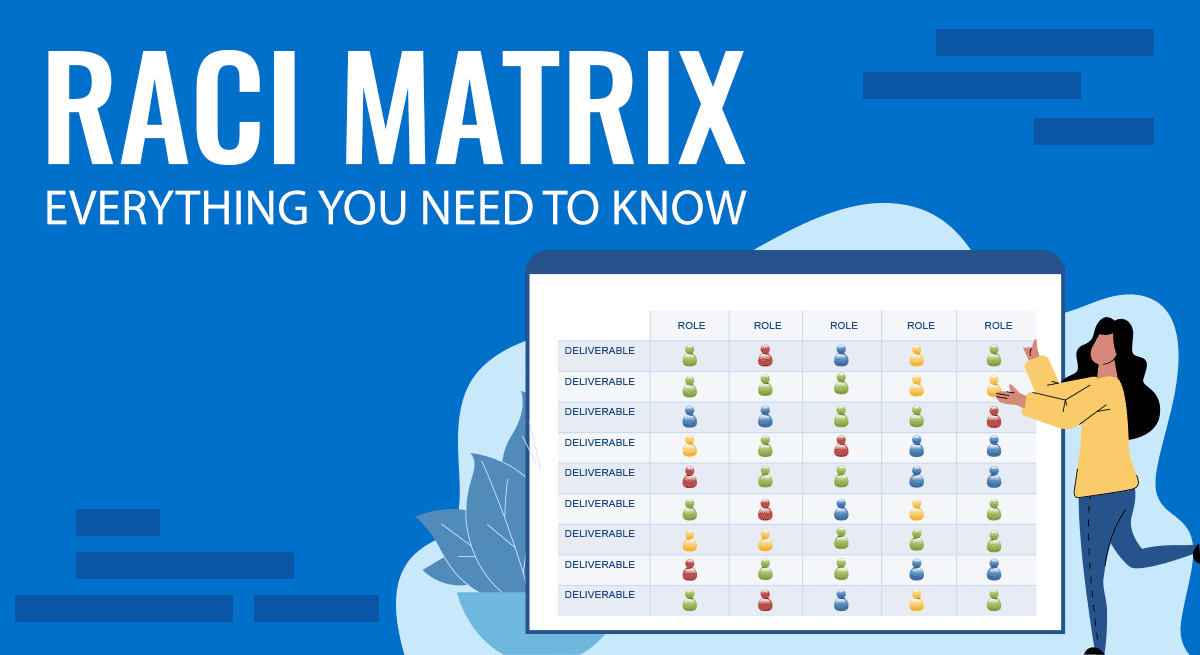
The roles and responsibilities for the execution of a project can sometimes be confusing. When roles aren’t properly defined, it becomes difficult to hold individuals accountable for their actions. Therefore, it is important to know who is responsible for what and create a mechanism to hold people accountable to ensure the smooth and effective execution of projects and business processes. One way to do that is to use the RACI Matrix.
What is a RACI Matrix?
RACI stands for responsible, accountable, consulted, and informed. The RACI matrix, as the name suggests, is a matrix for responsibility assignment. It is created in the form of a linear chart, describing roles and responsibilities for departmental or cross-functional processes and projects.
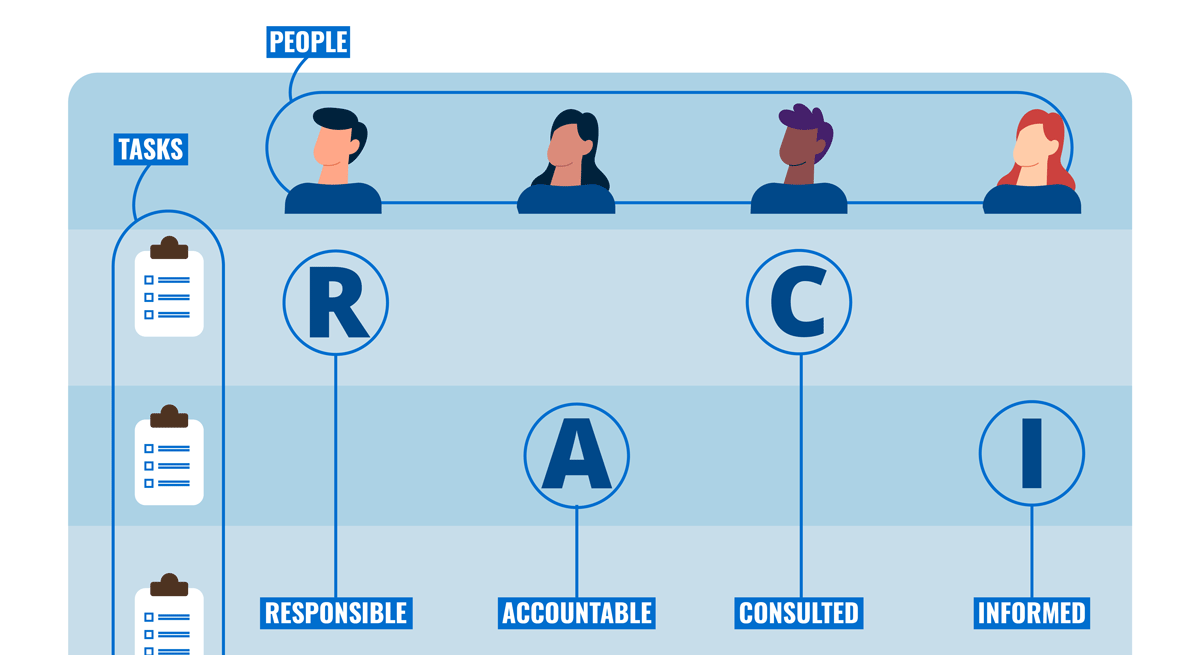
RACI matrix is used with an aim to help ensure project success. It can also be useful for the smooth execution of business processes. The four roles in the RACI matrix are meant to broadly cover the roles of stakeholders.
Responsible
Responsible in the RACI chart implies anyone who must complete a task or make a decision. In other words, anyone responsible for getting something done is assigned with an R. Using this roles and responsibilities matrix, several people who might be responsible for various tasks and decisions can be defined in the form of a chart.
Accountable
People who are deemed accountable in the RACI matrix include individuals who must sign off or approve tasks, decisions, and objectives. It is worth mentioning here that only one person can be accountable for a task and deliverable. This is important to remember to correctly use the RACI matrix.
Consulted
Consulted includes individuals who are subject matter experts or whose opinion is considered for input before the work is signed off. These active participants are kept in loop so that they can provide timely input.
Informed
People who might be required to receive updates on the project or progress of executable tasks fall in the informed section on the RACI Chart. These people don’t directly contribute to the task or decisions.
Understanding Responsible vs Accountable in the RACI Model
In a roles and responsibilities matrix, the same person can be both responsible and accountable for a task, however, not everyone responsible for a task can be held accountable. This is because while there might be several people responsible for a task (such as members of a team), only one individual can be accountable to sign off tasks, approve decisions and be responsible for deliverables. The one who is accountable is not only charged with the successful execution of the task but is also answerable in case there is a failure to provide deliverables on time.
How to Create a Roles and Responsibilities Matrix?
We have listed a few easy steps that you can follow to create a properly constructed Roles and Responsibilities Matrix.
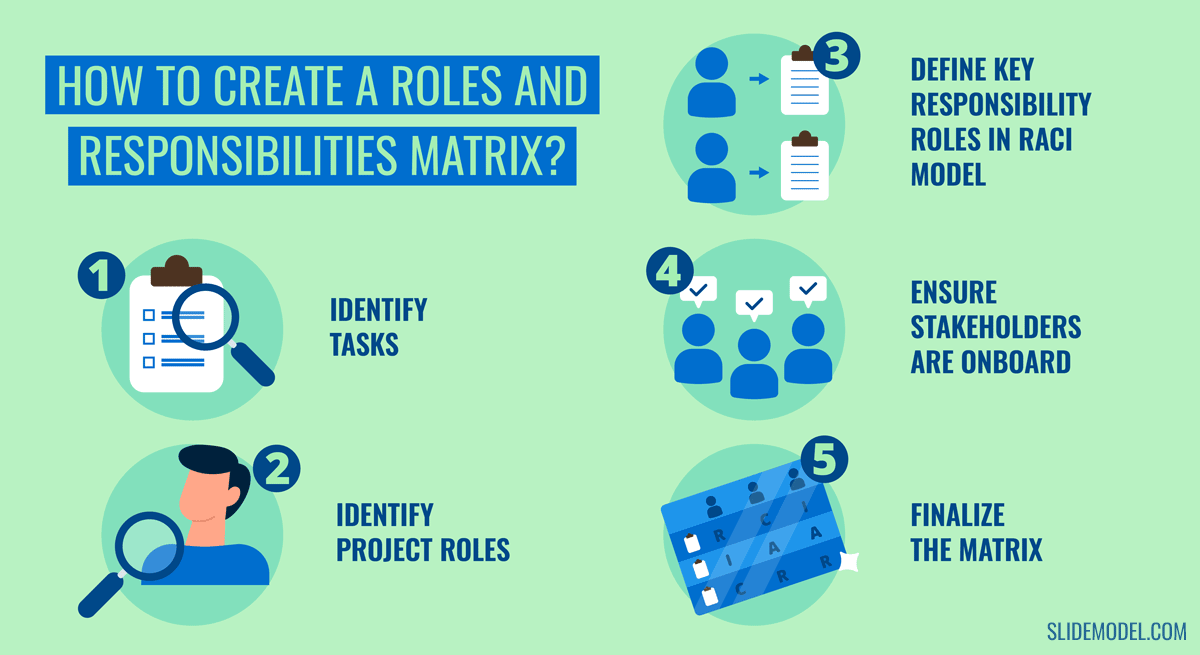
Identify Tasks
The first step in creating the RACI matrix is to identify all the tasks involved in a project and to list them. These tasks need to be listed on the left of the RACI chart in proper order of execution.
Identify Project Roles
In the next step, identify all the stakeholders and list them at the top of the RACI Chart. This will be the list of people who will have different roles in the execution of the project.
Define Key Responsibility Roles in RACI Model
Once the tasks and stakeholders have been listed, it’s time to define which individual will be responsible for what role in the matrix. To do this, you will require filling in the remaining cells in the RACI chart with who is responsible, accountable, consulted, and informed.
Ensure Stakeholders are Onboard
While it might be simple enough to create a RACI matrix, ensuring that everyone is on board is equally important.
If people are given a responsibility, are held accountable, need to be consulted or informed, it is also important that they know and agree with their roles in the RACI matrix. If people aren’t on board or lack commitment towards their defined role, this can lead to a major problem in ensuring project success or the proper execution of a business process. This is also the step where you should look to resolve ambiguities and possible conflicts to ensure everyone is on board.
Finalize the Matrix
It is quite possible that parts of the RACI Chart might need to be reorganized after consultation with stakeholders. Regardless of whether the matrix remains the same or is altered, you can finalize it once the stakeholders have been consulted, and any possible conflicts or ambiguities have been resolved.
Quick Tips for Using a RACI Chart in Project Management
When constructing the RACI matrix or consulting stakeholders, it is important to ask a few key questions to ensure everything is in order and the matrix is constructed properly. Below is a list of a few things you should consider before finalizing your RACI chart.
Ensure There Aren’t Too Many or Too Few Rs in the Chart
There are employees that are really good at their job and then there are individuals who might be less efficient or might not have a great reputation in getting things done. This also means that the people deemed most reliable can end up with more than fair share of work. However, efficient individuals should not have to make up for the inefficiencies of others. Instead, it’s important to ensure that the team is robust enough to get things done. This is why it is important that there aren’t too many Rs (responsibilities) assigned to a few people in the RACI Chart.
Ensure Every Person Accountable has one A
Everyone who is accountable can only be assigned a single A for a task. As mentioned earlier, it is important to have only one accountable person per task and deliverable.
Avoid Too Many Cs
Are there too many people being consulted? Could this slow down the execution of tasks? These are important considerations when constructing or finalizing the RACI matrix. You can look at the Rs and Cs to see if some of them need to be swapped for the smooth execution of tasks.
Ensure There are No Empty Cells
It is important to ensure there are no empty cells in the RACI Chart and all required sections are properly covered. It is also essential to ensure that cells aren’t hastily filled in just to complete the matrix, but are carefully filled out to make the matrix effective.
Ensure Stakeholders are Properly Included in the RACI Chart
When writing down the stakeholder at the top of the roles and responsibilities matrix, make sure everyone who needs to be in the matrix is covered. Afterthoughts of including people who were not deemed stakeholders aren’t feasible.
Use a RACI Matrix Template to Save Time
If you want to save time preparing and presenting the components of a RACI matrix to an audience, you can use a pre-defined RACI Matrix template for PowerPoint or Google Slides. At SlideModel, we have a large collection of templates available for presentations. You can download an editable RACI Matrix template, like the RACI Matrix PPT template.
Is RACI Matrix Good for Scrum Teams and Agile Projects?
A properly designed RACI matrix can also be useful for SCRUM and Agile projects. For this purpose, you can also add an ‘F’ (Facilitate) to the matrix. This can cover the role of the one who facilitates and organizes activities. You might also need to balance flexibility and rigid roles to facilitate self-organizing teams in the matrix.
Pros and Cons of using RACI Matrix
There are many advantages and disadvantages that need to be considered before incorporating RACI Matrix for your projects or business processes. While RACI might be suitable for an organization, does your organization have what is needed to use RACI effectively? Let’s take a look at a few pros and cons of using the RACI matrix.
Pros
RACI Matrix can Provide Structure and Clarity for Projects
RACI matrix can be useful for providing a proper structure for projects. It can enable mapping all the tasks, stakeholders, and provide clarity regarding the assigned roles.
Helps Identify Roles and Responsibilities
RACI Chart can help remove ambiguities in the roles, responsibilities, accountability, and execution of projects.
Can Help Improve Accountability
When roles aren’t properly defined, there can be ambiguities and question marks regarding the commitment of the people involved. Placing responsibilities in a well-defined box and ensuring that someone is accountable for deliverables can help make things more transparent and enable placing the blame in case of failure of timely deliverables.
The Right People can be Consulted According to Need
A RACI matrix can help identify if there are too many Rs or Cs to ensure there aren’t too many people consulted or given extra responsibilities. By balancing responsibilities and the people who are consulted, the right people can be consulted according to need and unnecessary consultation steps which might result in the slow down of work can be removed.
Useful for Cross-functional or Departmental Projects and Processes
RACI Chart is useful for cross-functional or departmental projects and processes. Its linear structure helps easily chalk out the people responsible and accountable for tasks and deliverables while ensuring amalgamation with cross-functional and departmental structures.
Cons
RACI Does not Reflect Specific Obligations and Responsibilities
A RACI matrix can be more of a broad overview of the way roles are defined for a project and can lack specific information associated with the obligations and responsibilities that each individual must perform. The matrix might not be effective to properly cover the roles of specific employees or contractors.
It Might be Hard to Balance Rs, As, and Cs
Balancing the responsibilities, accountability, and who is consulted can be tricky. Sometimes, there might be a need to overlap tasks that the matrix does not allow. For example, small businesses might need to hold one person accountable for multiple tasks due to a lack of resources and the vast skill set of the individual. Balancing the Rs, As, and Cs can therefore become hard, especially when an organization is pressed for resources.
Suitable Mainly for Large Projects
A RACI matrix is suitable for large projects and can be hard to use for small projects or organizations where multitasking and changing hats is inevitable due to the small workforce and lack of funds available to run operations.
Might not be Suitable for All Organizational Structures
Since RACI Chart is a linear matrix, it can be hard to adapt it for all organizational structures. Furthermore, some organizations might prefer fewer people to make decisions and micromanagement might even be a necessity due to the lack of an experienced workforce. Startups often suffer from this dilemma, where decision-making might rest with the founder or a handful of people, with careful management of employees to ensure the organization can survive on a shoestring budget in the short term.
A RACI matrix might also be hard to implement for certain types of organizational structures such as a network organizational structure.
RACI Matrix Can Slow Down a Project or Process
Despite using RACI Chart, ambiguities, workload inefficiencies, additional expenses, and a slowdown in the execution of projects or processes can occur. Before using RACI Chart, you need to ensure if it fits with your organization’s structure and requirements.
Before we go
A project can be structured for success not based on the RACI matrix alone. The organization and stakeholders need to be on board to create an environment where the matrix can serve as a tool for the successful execution of a project or business process.
When using the RACI chart, a huge burden to ensure its proper design and execution rests on the shoulders of the project manager. Therefore, we can say that the use of the matrix requires commitment, careful considerations, and the proper mapping of tasks, deliverables, stakeholders, responsibilities, accountable individuals, consultants, and the people who need to be informed during the execution of the project. A lot of this requires the project manager to ensure the matrix is created effectively, with stakeholders onboard for its execution, amidst no ambiguities that might lead to hiccups in project execution. In other words, a RACI chart is as effective a tool as the people engaged in its use, with the project manager required to lead the way forward.
FAQs
How does RACI differentiate between Responsible and Accountable?
While several individuals may be Responsible for executing a task, only one person is Accountable for its success, approval, and outcomes. The Accountable individual ensures the task is completed and answers for failures or delays.
Why is the RACI Matrix important?
The RACI Matrix ensures clarity in roles and responsibilities, enhances accountability, avoids role overlaps, and facilitates smooth project execution.
Can a RACI Matrix be used in Agile or Scrum projects?
Yes, the RACI Matrix can be adapted for Agile or Scrum projects. Adding an additional role like Facilitate (F) can account for roles like Scrum Masters or facilitators who organize and support activities.
Is a RACI Matrix suitable for small projects?
The RACI Matrix is typically more effective for larger projects. For small projects, its rigid structure might not fit environments where individuals multitask or perform overlapping roles.
How do you handle conflicts or ambiguities in a RACI Matrix?
Engage all stakeholders during the matrix creation to resolve conflicts. Revisit and adjust roles where necessary, ensuring everyone agrees on their responsibilities and accountability.
What organizational structures might struggle with implementing a RACI Matrix?
Startups, network organizations, or hierarchical structures with centralized decision-making might find the RACI Matrix challenging due to overlapping roles, resource constraints, or rigid workflows.
What is the role of the project manager in a RACI Matrix?
The project manager ensures the matrix is effectively created and executed. They resolve ambiguities, assign roles appropriately, and ensure stakeholder alignment to facilitate smooth project progress.
RACI Chart Examples
At SlideModel we seek to provide complete and useful information, so that the end user can get the most out of it and find what is looking for. In this section we present some of our most recommended RACI Chart Examples, which you can find in our RACI Chart Templates section.
